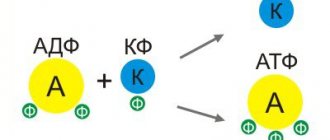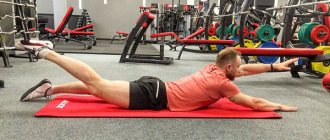What is endurance?
Endurance is the ability to perform physical work without reducing its effectiveness. A resilient person can perform a certain movement for a long time without experiencing any particular difficulties and without getting so tired that he is forced to stop.
True, here it is worth immediately understanding what periods of time and what kind of work we are talking about. And about what loads. For example, you can jog for literally hours. Is it endurance? Yes. What is it to do a set of 30 pull-ups? This is also endurance! But in other exercises. And, of course, no one can do pull-ups for several hours in a row. A few minutes at most. You can do push-ups on the floor for 10-15 minutes. This is also endurance that can be trained.
What kind of endurance is there?
There are many opinions about what types of endurance there are. Endurance is divided into muscular, cardiac, general, special, strength, etc.
Since I deal with fitness and sports physiology professionally, I must say that there is no general endurance. There is only muscular endurance. And to some extent we can talk about the endurance of the heart. I talked about this type of endurance and its training in the article about stroke volume of the heart.
In practice, it always comes down to endurance in a particular exercise or movement. And this is easily verified experimentally. If a person is an excellent long-distance runner, this does not say anything about his ability to do push-ups or squat with a 70 kg barbell for the amount. However, the opposite is also true. An excellent barbell lifter who can squat 100kg for 50 reps may turn out to be a poor runner or swimmer. And all for one important reason.
Exercises to develop endurance. What's the benefit?
One of the most obvious and important benefits of endurance training is improved overall health. Also important are such advantages as weight loss, strengthening the cardiovascular and respiratory systems. The proposed exercises are basic, but it is important to remember that bringing the technique of their implementation to the ideal indicates your technical and physical success in the most difficult workouts - you can easily increase your strength and speed indicators.
But do not forget that most of the proposed exercises have contraindications for implementation. If you have any injuries in places that are, one way or another, involved in a certain exercise, then you need to refuse to perform it. Also, you should not continue the exercise if you experience pain - or you need to check the correctness of your technique, or simply interrupt the approach due to the fact that the exercise being performed is not suitable for you for some reason.
The main property of endurance is specificity
Alas, endurance is an extremely specific quality. By developing it in one direction, we do not develop endurance in other exercises. It is a fact.
To some extent, from a certain level of development, the principle of synergy begins to operate, when development in one area of training helps in other areas. But this effect is quite weak. More often than not, we develop great endurance in the movement in which we train the most. And if we slightly change the type of movement, the endurance in it decreases sharply. And it has to be developed again in this exercise.
For example, if you perfectly train your ability to do push-ups, this will have almost no help in doing pull-ups on the horizontal bar. And so it is in almost everything that concerns endurance.
To train endurance, train it in exactly the exercise for which you need it.
It doesn't make much sense to run to increase your boxing endurance. It’s better to box more and practice the necessary movements. There is no point in doing quantity squats for runners. It is better to run at the required pace. Always do the same and you will get very good results.
Aerobic and anaerobic endurance
Performing each exercise involves aerobic and anaerobic power, the degree of development of which largely determines the ratio of duration and correct execution of a physical, technical or tactical element.
Aerobic endurance (oxygen) is a type of body work that occurs with the active use of oxygen as fuel. At the same time, oxygen consumption is approximately equal to the rate of its supply to the exerciser’s body. The result is waste that is easily released through the sweat secretions.
There are several types of aerobic work:
- Short (lasts up to 8 minutes)
- Medium (lasting from 8 to 30 minutes)
- Long (lasts more than 30 minutes)
Depending on the duration of aerobic work, the percentage of oxygen debt increases. Otherwise it is called PAO or aerobic metabolic threshold. The aerobic threshold is the point above which the body goes into anaerobic mode, that is, it begins to consume more oxygen. Occurs at approximately 60-70% of the maximum heart rate (132-154 beats per minute).
Aerobic endurance training occurs through interval and continuous exercise. Interval training can include running in segments or several sets of shuttle running. Continuous training is normal running for as long as possible.
Anaerobic endurance (without oxygen) is a type of body work that exceeds oxygen consumption relative to its supply. That is, the body begins to work on debt.
This type can occur as a result of prolonged work in an aerobic mode or when performing anaerobic exercise (sprinting). As a result of anaerobic work, lactic acid begins to accumulate in the muscles, which causes fatigue (muscles are clogged).
Anaerobic endurance has several types:
- Short (up to 25 seconds)
- Medium (25 to 60 seconds)
- Long (60 to 120 seconds or more)
As you can see, anaerobic work has a shorter duration, but the oxygen debt appears and grows much faster than during aerobic work. The reason is the high intensity of the work performed.
The threshold of anaerobic metabolism or PANO occurs when the number of heart beats is 80-90% of the maximum value (176-198 beats/min.). During anaerobic work, the heart and the body as a whole work to the limit of their capabilities.
If after aerobic endurance anaerobic endurance is switched on, then what happens after overcoming the PANO of almost 200 blows? All body functions that contribute to high-intensity work slow down. Thus, working at the maximum pace is possible for no more than 10 seconds. In rare cases, if the body is under the influence of stimulant drugs (adrenaline), “heart rupture” may occur due to too high a frequency of contractions.
Anaerobic endurance training is important for short and medium distance runners where you need to maintain a high pace. It can be developed by repeating high-intensity exercises, reducing recovery time. For example, alternating running with accelerations or sprinting with reduced recovery time.
It is better to calculate the thresholds for aerobic and anaerobic metabolism from percentages, rather than taking the data given in parentheses as your own. Since everyone has a different level of development of the cardiovascular system, the number of heartbeats calculated from the percentage may differ from those given as an example. The approximate number of beats is calculated from the average maximum heart rate of 220 beats per minute.
Endurance exercises
I've chosen eight different exercises that are great for endurance training. These exercises are also good because they give good side effects: your overall physical fitness improves, with appropriate nutrition and frequency of training, a good weight loss effect is obtained.
Of course, using the knowledge from this article, you can develop endurance in any other exercises. So, my endurance exercises.
Walking on a treadmill
Many people think that a treadmill is only for running. In fact, the best exercise on a treadmill is walking. Walking is very good for developing endurance. It is especially convenient that modern paths allow you to change the angle of inclination, which makes it possible to “walk uphill.” Walking uphill is one of the best ways to develop leg endurance. Adjust the angle of inclination, up to the steepest, increase the walking time, take additional weight in your hands. This is a great endurance exercise! I recommend detailed instructions for walking on a treadmill.
Run
Remembering that running only develops endurance through running, I can recommend running to develop endurance. Gradually increase the distance or time of running, depending on your goals. Beginners most often have the task of maintaining a certain distance (say, 3-5 km) without stopping. If a month ago you couldn’t cover a distance of 3 kilometers without stopping, but now you can, it means your endurance has increased. For experienced ones, the task is different - to reduce the time it takes to cover the distance. If at a distance of 10 km you managed to reduce your race time by 15-30 seconds, it means that you have definitely become stronger and faster. Train exactly what you need. Measure your endurance in specific numbers! This simplifies everything. This article will help you on how to run correctly.
Running is one of the ways to develop endurance
Jumping rope
Another luxurious exercise for developing endurance. At first, you can achieve 200-500 continuous jumps. This is a serious task for a beginner. Then increase the number to 1000 jumps in total or even in one approach. Well, the next step is to learn how to perform a series of double jumps with a skipping rope. This is when in one jump the rope manages to make two full turns. Be sure to use high-quality shoes when jumping rope to protect your leg joints from damage.
Squats
Use regular squats without weight for quantity. Let's say set your new record by 200, 300 or even 500 times! Or do squats with a barbell of a certain weight, with which you need to squat a certain number of times. The idea of learning how to squat a 70kg barbell for 50 reps in one set is a daunting goal for many gym goers. I think there is no need to explain how seriously your endurance will increase and how noticeably your appearance will change if you achieve this goal. The weight of the barbell for ladies can be reduced to 20-30 kg if you are scared :)
Pushups
This is one of the most accessible endurance exercises. And one of the most understandable, since it is very easy to set and achieve certain values: 20 push-ups, 30 push-ups, 50 push-ups per set. And each new record will mean that you are becoming more resilient! Your triceps, chest muscles, abdominal muscles and thighs are definitely becoming more and more resilient. Use different types of push-ups!
Pushups. Starting position – lying position.
Pushups. Lower position – arms bent at the elbows.
Burpee exercise
This is one of the best exercises for endurance and general fitness. Essentially, a burpee is an alternation of push-ups and jumping jacks. You need to take a lying position, do a push-up, then quickly stand up and jump up. Repeat many, many times! Trained people can do burpees 50-100 times per approach. This is a great endurance workout! Read more about the burpee exercise.
Kettlebell exercises for endurance
Kettlebell exercises are great for developing endurance. You can use almost any exercise from kettlebell lifting: clean and jerk, snatch, throw, etc. In my opinion, a very good endurance exercise is the kettlebell snatch. If you master it technically correctly (especially the soft kettlebell hold on the wrist), you will have no problem doing it literally hundreds of times! This is a great endurance workout! Don't let the kettlebell hit you on the wrist, learn to accept it correctly. Learn more about the kettlebell snatch exercise.
Plank
This is an excellent static exercise. All static exercises develop endurance in one way or another. But this endurance is of a special kind. You become more resilient in this particular position, in the one you occupy when performing the exercise.
Performing a plank: Take the correct position and hold it for at least 30 seconds. Gradually increase the time you hold the plank to 60 seconds or more. The longer you hold out, the more endurance you have!
Exercise plank for abdominal muscles
I believe, dear reader, you have already understood that you can and should use a variety of exercises to develop endurance. Not necessarily just these. The main thing is to remember the rule of endurance specificity. And choose those exercises that you really need, in which you want to develop endurance. Practice them.
Types of endurance
There are a huge number of disciplines where endurance plays an important role in achieving results. A marathon runner and a weightlifter have a fairly developed quality, but the specifics of the exercises they perform are completely different. This suggests that there are several types of endurance that are responsible for different muscle groups and different activities.
Depending on the type of activity, general and special types of endurance are distinguished.
General endurance is considered to be the physical capabilities of the body aimed at performing a nonspecific type of activity. The intensity of the exercise is at a normal level, mainly large and medium muscle groups are involved. This type determines the level of general performance in sports and professional activities.
This type of endurance is directly related to the aerobic power of the body, that is, the body’s ability to work in comfortable conditions without the formation of an oxygen debt and the inclusion of small muscle groups in the work.
The development of general endurance is comprehensive. This complex word hides the indirect development of a result in another activity.
If, as a result of regular running, it was possible to increase the level of aerobic power, then the improvement in this quality will affect other aerobic exercises. That is, with the help of running you can indirectly influence the result in swimming, since general endurance does not have a specific focus.
Special endurance is aimed at performing long-term specific loads that are characteristic of a particular sport or profession. This type of endurance is characterized by anaerobic work, that is, performing an exercise for a long time with the formation of an oxygen debt.
Special endurance is a more complex physical quality because it forces small muscle groups to work. Performing such work requires training motor skills and good coordination, as well as the right mental attitude.
It is the special resistance of the body that is the difference between athletics and weightlifting endurance.
It is called special because of the specific skills and abilities that are characteristic of a certain type of activity during work or physical exercise. For example, short-distance running and ultramarathoning have well-developed special endurance, but each has a different set of skills and abilities, as well as different development of large, medium and small muscle groups. As well as different degrees of development of aerobic and anaerobic power.
Drawing a parallel between general and special endurance, it can be noted that special, unlike general, does not provide an additional effect when performing other types of activities. Remember that by training aerobic power by running, we can indirectly influence the result in swimming. So, in the case of special endurance, such a technique has a weak effect or is absent altogether. Special endurance training leads to the development of qualities characteristic of a particular discipline: running, jumping, throwing, pushing.
Therefore, special endurance is divided into several separate types:
- Express
- Speed-strength
- Coordination
- Power. In turn, strength endurance is further divided into dynamic and static.
Speed is characterized by a person’s ability to perform fast movements for a long time without fatigue or disruption of technique. Develops with the specified focus of exercises. For example, performing accelerations.
Speed-strength has a similar definition as speed endurance. There is only a slight difference. Speed-strength ability is characterized by the performance of actions of a high activity of a power nature for a long time. That is, if speed endurance is performing fast movements, then speed-strength endurance is the same, only performing strength exercises.
Coordination endurance manifests itself through repeated repetition of complex technical and tactical actions. It is especially evident in sports games and gymnastic exercises. In running it is less important, since the nature of the movements is predominantly cyclical.
Strength endurance refers to the muscular ability to perform heavy exercise for long periods of time without visible technical impairment. This type of endurance shows the ability of muscles to contract again after a minimum period of time.
- Dynamic strength endurance is characterized by performing heavy muscle exercises at a relatively slow pace, but for a fairly long time.
- Static endurance allows you to maintain muscle tension for a fairly long period without changing your posture. Usually only certain muscle groups work, and the higher the degree of tension, the shorter the duration of the exercise.
When addressing the issue of types of endurance, quite a lot of attention was paid to the aerobic and anaerobic power of the body.
How to develop endurance?
First of all, decide in which movement or exercise you want to develop endurance. We have already discussed the most important property of endurance - specificity. And we already know that it is hardly possible to simply be resilient in all exercises and movements without exception.
When developing endurance, a linear method of increasing the number of repetitions, distance or work time is most often used.
For example, you want to increase your jogging endurance, that is, you want to increase the distance you can run without stopping. Let’s say that now you can do 2 kilometers. Do you want to run 3 km? Then the running endurance training program will look like this:
| Week number | 1 | 2 | 3 | 4 | 5 | 6 | 7 | 8 |
| Distance | 1000m | 1400m | 1700m | 2000m | 2200m | 2500m | 2700m | 3000m |
Jogging training should be done at least 3-4 times a week.
In a similar way, you can develop endurance in push-ups. Let's say your record is now 35 repetitions. You want to achieve 45-50 times. An endurance training system might look like this:
| Week number | 1 | 2 | 3 | 4 | 5 | 6 | 7 | 8 |
| Sets and reps | 2-3x17 | 2-3x22-24 | 2-3x28-30 | 2x35 | 1-2x37 | 1-2x39 | 1-2x42 | 1-2x45 |
Also do push-up training no more than 3-4 times a week. Important: perform all training approaches in an explosive style. Rest between sets until your breathing is completely restored.
There are other, more complex and effective methods for developing endurance. I’ll talk about them in another article about developing endurance. You can also get acquainted with them in practice at my trainings and in individual sets of exercises.
Remember: when training for endurance, it is very important to take care of recovery between sessions. If you do not recover, the growth of endurance will slow down or even roll back. This requirement is especially important to take into account for people with extra pounds. Externally, endurance training and sets of exercises for weight loss are similar. But the requirement for recovery is especially critical during endurance exercise.
Endurance and ways to develop it
Typically, endurance is understood as the ability to work without getting tired and to withstand fatigue that occurs in the process of doing work.
There are general and special endurance. General endurance is understood as the body’s ability to perform work at moderate intensity for a long time with high efficiency. Special endurance is the ability to endure long-term loads characteristic of a particular type of activity.
To develop endurance, a variety of training methods are used, which are divided into continuous and interval training methods. Each method has its own characteristics and is used to improve certain components of endurance, depending on the parameters of the exercises used. By varying the type of exercise, its duration and intensity, the number of repetitions of the exercise, as well as the duration and nature of rest, you can change the physiological orientation of the work performed.
The uniform continuous method consists of a single uniform performance of exercises of low and moderate power lasting from 15 to 30 minutes. and up to 1-3 hours. This method develops aerobic abilities.
The variable continuous method is characterized by periodic changes in the intensity of continuously performed work. The body works in a mixed aerobic-anaerobic mode.
The alternating continuous method is designed to develop both specific and general endurance. It allows you to develop aerobic capabilities, the body’s ability to tolerate hypoxic conditions that periodically arise during acceleration and are eliminated with a subsequent decrease in the intensity of the exercise, teaches those involved to “endure”, cultivating volitional qualities.
The interval training method consists of dosed repeated exercises of a relatively short duration (up to 2 minutes) after strictly defined rest intervals. This method is usually used to develop specific endurance for a particular job. This method can develop both anaerobic and aerobic components of endurance.
When starting work on developing endurance, it is necessary to adhere to a certain sequence of training. At the initial stage, it is necessary to focus on developing aerobic capabilities, improving the functions of the cardiovascular and respiratory systems, strengthening the musculoskeletal system, i.e. development of general endurance. At the second stage, it is necessary to increase the volume of loads in a mixed aerobic-anaerobic mode. At the third stage, it is necessary to increase the volume of loads through the use of more intense exercises performed by the methods of interval and repeated work in mixed aerobic-anaerobic and anaerobic modes, and selective impact on individual components of special endurance.
To develop general endurance, the simplest and most accessible is jogging. When starting running training, you should remember and follow the following rules:
- warm up thoroughly before training;
- Thick socks made of a mixture of wool and cotton should be worn on your feet;
— the load should increase gradually;
— you should run at least 3 times a week and for at least 20 minutes;
— you should not increase your running speed even when you see other runners or beautiful girls :))
— you should constantly strengthen the muscles of the arch of your feet to avoid the development of flat feet;
— the greatest training effect is achieved when the running time approaches 1 hour;
- you should monitor your pulse rate (HR) - it should not be more than 180 beats per minute. minus your age.
To develop special endurance, “shadow boxing” and exercises on apparatus are most often used: performing 5 - 6 series of 20 - 30 seconds. intensive work alternating with low-intensity work for 1 - 3 minutes. With increasing training, the duration of recovery work can be reduced towards the end of the series. After such a series, a rest of up to 10 minutes is required, during which breathing exercises and relaxation and flexibility exercises are performed.
You can use jumping exercises (for example, jumping rope): 10 - 15 sec. repeat intensive work 5 - 6 times every 1.5 - 2 minutes. low intensity work.
(When writing this section, materials were used from the book: Zakharov E.N. et al. Encyclopedia of Physical Training. - M.: Leptos, 1994.)











